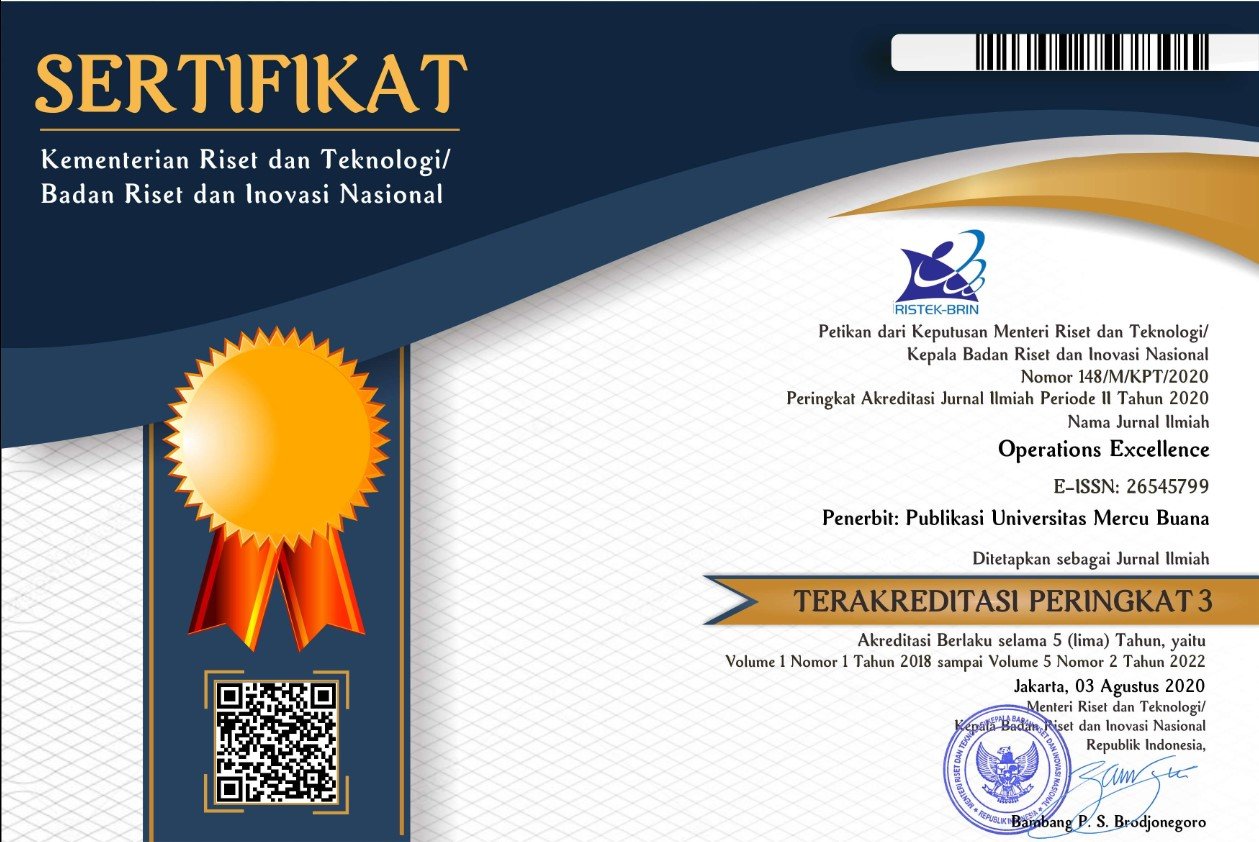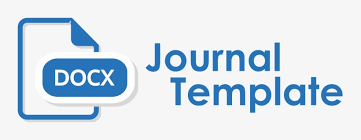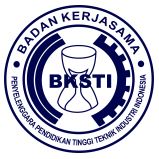Developing a transformation readiness index for Industry 4.0: a case study of food logistics in the rice commodity sector
Abstract
In 2021, it was recorded that Indonesia had a population of 272,682.50 million people, which then underwent an increase of 1.12% from the previous year to 275,773.80 million people in 2022. The rapid growth of the population will affect the food supply in Indonesia. It is known that many provinces in Indonesia still have a percentage deficit in food distribution, especially in the rice commodity, which needs to be improved to meet projected annual needs. This research tries to develop a transformation index by combining the Industry 4.0 concept model with the logistics operating in the food sector. To improve food security in Indonesia by transforming towards Industry 4.0. Research with a qualitative descriptive approach produces several factors that can influence the transformation index of food logistics companies in Indonesia towards Industry 4.0. The results of the use of technology, especially in encouraging transparent and real-time data transfer (horizontal and vertical) and decision-making in the logistics sector, are critical to pay attention to. However, organizational management, culture, and human resources are also essential things to pay attention to in transformation.
Keywords
Full Text:
PDFReferences
Almamalik, L. (2020). The Development of the Maturity Model to Assess the Smart Indonesia Manufacturing Companies 4.0 Readiness.
Amr, M., Ezzat, M., & Kassem, S. (2019). Logistics 4.0: Definition and Historical Background. NILES 2019 - Novel Intelligent and Leading Emerging Sciences Conference, 46–49. https://doi.org/10.1109/NILES.2019.8909314
Badan Pusat Statistik. (2022a). Distribusi Perdagangan Komoditas Beras di Indonesia 2022.
Badan Pusat Statistik. (2022b). Statistik Indonesia: Statistical Yearbook of Indonesia.
Bantacut, T., & Fadhil, R. (2018). Application of Logistics 4.0 in Rice Supply Chain Management at Perum Bulog: An Initial Idea. https://www.researchgate.net/publication/328495618
Çınar, Z. M., Zeeshan, Q., & Korhan, O. (2021). A framework for industry 4.0 readiness and maturity of smart manufacturing enterprises: A case study. Sustainability (Switzerland), 13(12). https://doi.org/10.3390/su13126659
Dallasega, P., Woschank, M., Sarkis, J., & Tippayawong, K. Y. (2022). Logistics 4.0 measurement model: empirical validation based on an international survey. Industrial Management and Data Systems, 122(5), 1384–1409. https://doi.org/10.1108/IMDS-11-2021-0694
De Carolis, A., Macchi, M., Negri, E., & Terzi, S. (2017). A Maturity Model for Assessing The Digital Readiness of Manufacturing Companies. IFIP Advances in Information and Communication Technology, 513, 13–20. https://doi.org/10.1007/978-3-319-66923-6_2
EDB Singapore. (2020). The Smart Industry Readiness Index. www.edb.gov.sg.
Elibal, K., Özceylan, E., & Çetinkaya, C. (2020). A Study of Maturity Model For Assessing The Logistics 4.0 Transformation Level Of Industrial Enterprises.
Felch, V., Asdecker, B., & Sucky, E. (2018). Digitization in Outbound Logistics - Application of an Industry 4.0 Maturity Model for the Delivery Process. https://doi.org/10.1201/9780429327636-27
Galindo, L. D., & Wang, K. (2016). The Challenges of Logistics 4.0 for the Supply Chain Management and the Information Technology.
Global Food Security Index. (2022). Country Report: Indonesia.
Hajoary, P. K. (2023). Industry 4.0 Maturity and Readiness- A case of a Steel Manufacturing Organization. Procedia Computer Science, 217, 614–619. https://doi.org/10.1016/j.procs.2022.12.257
Hasbullah, H., & Bareduan, S. A. (2023). Identifying weaknesses and strengths of existing I4.0 Readiness Indices to enhance INDI 4.0. 28(1). https://doi.org/10.22441/sinergi.2024.x.xxx
Hasbullah, H., Bareduan, S. A., & Hasibuan, S. (2021). Developing I4.0 Readiness Index for Factory Operation in Indonesia to Enhance INDI 4.0. International Journal on Advanced Science, Engineering and Information Technology, 11(4), 1668–1677. https://doi.org/10.18517/ijaseit.11.4.14280
Ichsan, M., Dachyar, M., & Farizal. (2019). Readiness for Implementing Industry 4.0 in Food and Beverage Manufacturer in Indonesia. IOP Conference Series: Materials Science and Engineering, 598(1). https://doi.org/10.1088/1757-899X/598/1/012129
Jagtap, S., Bader, F., Garcia-Garcia, G., Trollman, H., Fadiji, T., & Salonitis, K. (2020). Food Logistics 4.0: Opportunities and Challenges. Logistics, 5(1), 2. https://doi.org/10.3390/logistics5010002
Jodlbauer, H., & Schagerl, M. (2016). Reifegradmodell Industrie 4.0-Ein Vorgehensmodell zur Identifikation von Industrie 4.0 Potentialen.
Kementerian Perindustrian. (2018). Indonesia Industry 4.0 Readiness Index.
Khan, S., Singh, R., Haleem, A., Dsilva, J., & Ali, S. S. (2022). Exploration of Critical Success Factors of Logistics 4.0: A DEMATEL Approach. Logistics, 6(1), 13. https://doi.org/10.3390/logistics6010013
Leyh, C., Bley, K., Schaffer, T., & Forstenhausler, S. (2016). SIMMI 4.0-a maturity model for classifying the enterprise-wide it and software landscape focusing on Industry 4.0. Proceedings of the 2016 Federated Conference on Computer Science and Information Systems, FedCSIS 2016, 1297–1302. https://doi.org/10.15439/2016F478
Lichtblau, K., Stich, V., Bertenrath, R., Blum, M., Bleider, M., Millack, A., Schmitt, K., Schmitz, E., & Schröter, M. (2015). Impuls: Industrie 4.0-Readiness. Impuls Stiftung Des VDMA, Aachen-Köln.
Maria, S., Darma, C., Amalia, S., Hakim, Y. P., & Pusriadi, T. (2020). Readiness To Face Industry 4.0. Article in International Journal of Scientific & Technology Research, 8(09 September 2019). www.ijstr.org
Moleong, L. J. (2012). Metodologi Penelitian Kualitatif. PT Remaja Rosdakarya.
Monshizadeh, F., Moghadam, M. R. S., Mansouri, T., & Kumar, M. (2022). Developing An Industry 4.0 Readiness Model Using Fuzzy Cognitive Map Approach. International Journal of Production Economics, 7–10. https://doi.org/10.1016/B978-012370624-9/50005-0
Nick, G., Kovács, T., Ko, A., & Kádár, B. (2020). Industry 4.0 readiness in manufacturing: Company Compass 2.0, a renewed framework and solution for Industry 4.0 maturity assessment. Procedia Manufacturing, 54, 39–44. https://doi.org/10.1016/j.promfg.2021.07.007
Oleśków-Szłapka, J., & Stachowiak, A. (2019). The Framework of Logistics 4.0 Maturity Model. Advances in Intelligent Systems and Computing, 835, 771–781. https://doi.org/10.1007/978-3-319-97490-3_73
Ratnaningtyas, E. M., Ramli, Syarifuddin, Suliwati, D., Nugroho, B. T. A., Karimuddin, Aminy, M. H., Saputra, N., Khaidir, & Jahja, A. S. (2023). Metodologi Penelitian Kualitatif (N. Saputra, Ed.). Yayasan Penerbit Muhammad Zaini. https://www.researchgate.net/publication/370561417
Sartika, R. (2014). Optimasi Persediaan pada Rantai Pasok Beras untuk Program Raskin (Studi Kasus pada Perum BULOG Subdivisi Regional Cianjur).
Schuh, G., Rudolf, S., & Riesener, M. (2016). Design For Industrie 4.0. In Dubrovnik-Croatia.
Schumacher, A., Erol, S., & Sihn, W. (2016). A Maturity Model for Assessing Industry 4.0 Readiness and Maturity of Manufacturing Enterprises. Procedia CIRP, 52, 161–166. https://doi.org/10.1016/j.procir.2016.07.040
Schumacher, A., Nemeth, T., & Sihn, W. (2019). Roadmapping towards industrial digitalization based on an Industry 4.0 maturity model for manufacturing enterprises. Procedia CIRP, 79, 409–414. https://doi.org/10.1016/j.procir.2019.02.110
Schweichhart, K. (2016). Reference Architectural Model Industrie 4.0 (RAMI 4.0).
Sony, M., & Naik, S. (2020). Key ingredients for evaluating Industry 4.0 readiness for organizations: a literature review. In Benchmarking (Vol. 27, Issue 7, pp. 2213–2232). Emerald Group Holdings Ltd. https://doi.org/10.1108/BIJ-09-2018-0284
Sternad, M., & Lerher, T. (2018). Maturity Levels For Logistics 4.0 Based On NRW’s Industry 4.0 Maturity Model. 18th International Scientific Conference Business Logistics in Modern Management. https://www.researchgate.net/publication/329371288
Sun, X., Yu, H., & Solvang, W. D. (2022). Towards the smart and sustainable transformation of Reverse Logistics 4.0: a conceptualization and research agenda. In Environmental Science and Pollution Research (Vol. 29, Issue 46, pp. 69275–69293). Springer Science and Business Media Deutschland GmbH. https://doi.org/10.1007/s11356-022-22473-3
Suryana, A. (2014). Menuju Ketahanan Pangan Indonesia Berkelanjutan 2025: Tantangan dan Penanganannya. Forum Penelitian Agro Ekonomi, Vol. 32. No. 2. 2014.
Tan, H. S. R., Andhika, A., Ariyanti, F. D., & Soebandrija, K. E. N. (2019). Pengembangan Model Pengukuran Kesiapan Industri 4.0 Untuk Perusahaan Manufaktur di Indonesia. Jurnal PASTI, 13(2), 106. https://doi.org/10.22441/pasti.2019.v13i2.001
Werner-Lewandowska, K., & Kosacka-Olejnik, M. (2019). Logistics 4.0 Maturity in Service Industry: Empirical Research Results. Procedia Manufacturing, 38, 1058–1065. https://doi.org/10.1016/j.promfg.2020.01.192
Zoubek, M., & Simon, M. (2021). Evaluation of the level and readiness of internal logistics for industry 4.0 in industrial companies. Applied Sciences (Switzerland), 11(13). https://doi.org/10.3390/app11136130
DOI: http://dx.doi.org/10.22441/oe.2024.v16.i2.116
Refbacks
- There are currently no refbacks.
Copyright (c) 2024 Operations Excellence: Journal of Applied Industrial Engineering

This work is licensed under a Creative Commons Attribution-ShareAlike 4.0 International License.
Journal ISSN:
| Print ISSN: 2085-4293 | |
| Online ISSN: 2654-5799 |
Tim Editorial Office
Operations Excellence: Journal of Applied Industrial Engineering
Magister Teknik Industri Universitas Mercu Buana
Jl. Raya Meruya Selatan No. 1 Kembangan Jakarta Barat
Email: [[email protected]]
Website: http://publikasi.mercubuana.ac.id/index.php/oe
Journal DOI: 10.22441/oe
The Journal is Indexed and Journal List Title by:

.png)
.png)
.png)


Operations Excellence: Journal of Applied Industrial Engineering is licensed under a Creative Commons Attribution-NonCommercial-ShareAlike 4.0 International License.










